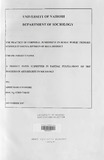| dc.description.abstract | This study is an effort to examine the practice of Corporal Punishment in rural public primary schools in Kenya. In order to give a conceptual explanation to this practice as a method of instilling and maintaining discipline. The debate on the practice of Corporal Punishment is symptomatic of a predicament that deserves some attention. The main objective of the study therefore was to establ ish the extent of the practice of corporal punishment, its perception by various stakeholders and to establish factors that account for its persistent use in spite of the ban. The study based its theoretical framework on various Sociological Theories ranging from Structural Functionalism, Behaviorist theory, Social Learning.
The study was carried out in Ugunja Division of Siaya District in Nyanza province. The study only covered corporal punishment in Rural Public Primary Schools focusing mainly on upper primary pupils. The respondents totaling to one hundred and twenty comprised various stakeholders in the educational enterprise such as pupils, teachers, Head teachers, parent officers from the Ministry of education and teachers service commission.
The study being qualitative research principally employed the descriptive approach in its Endeavour to clarify and analyze the concept of corporal punishment in so far as it affects the education practice and theory in Kenya. Both..... Primary and Secondary sources of data were
used. Interviewing was the main method of data c~ection, a questionnaire and a structured interview guide being the main tools of data collection. ,~
The study concludes with the actual situation on the use of corporal punishment in rural schools in the area and notes that the use of corporal punishment is still prevalent despite its ban by the government in the year 200 I. The mode of corporal punishment established in the findings are caning, pinching, slapping and kicking, from the study, majority of pupil's are subjected to corporal punishment and many consider it to be effective in changing pupil's behavior. A much stronger case has been made for reform as a reason for punishing children. The 'sharp shock' involved in punishment appears to have the capacity to bring children to
7
their senses from the world of fantasy and help establish them in socially more desirable forms of conduct. Corporal punishment therefore, is a social predicament not only practiced in schools but also in homes. This is because many parents adhere to the Biblical Solomon dictum that, "lie who spare the rod hates his son, but he who loves him is diligent to discipline him" (Proverbs 20:30; 22: 15).
Various factors that enhance this practice are also examined in the study and teachers particularly use corporal punishment because the available alternative forms of punishment have drawbacks and are difficult to implement. The study ends with recommendations that organically grow from discussions developed in the study such as:
• Regular visits to schools by the Ministry of Education to monitor the implementation of the ban would be ideal.
• Educationists should create awareness to the communities on the need to discard traditional modes of discipline like corporal punishment.
• Ministry of Education should stipulate forms of punishment to be used in schools.
It should also employ more teachers to reduce the big teacher: pupil ratio to enable the teachers to monitor and supervise alternative to corporal punishment. | en |

